Every once in a great while paleontological fieldwork turns up a fossil so extraordinary that it revolutionizes our understanding of the origin and evolution of an entire branch of the tree of life. Fifty years ago one of us (Johanson) made just such a discovery on an expedition to the Afar region of Ethiopia. On November 24, 1974, Johanson was out prospecting for fossils of human ancestors with his graduate student Tom Gray, eyes trained on the ground, when he spotted a piece of elbow with humanlike anatomy. Glancing upslope, he saw additional fragments of bone glinting in the noonday sun. In the weeks, months and years that followed, as the expedition team worked to recover and analyze all the ancient bones eroding out of that hillside, it became clear that Johanson had found a remarkable partial skeleton of a human ancestor who had lived some 3.2 million years ago. She was assigned to a new species, Australopithecus afarensis, and given the reference number A.L.288-1, which stands for “Afar locality 288,” the spot where she, the first hominin fossil, was found. But to most people, she is known simply by her nickname, Lucy. With the discovery of Lucy, scientists were forced to reconsider key details of the human story, from when and where humanity got its start to how the various extinct members of the human family were related to one another—and to us. Her combination of apelike and humanlike traits suggested her species occupied a key place in the family tree: ancestral to all later human species, including members of our genus, Homo.
It can be precarious to hang such a pivotal argument on a single fossil individual. But in the half a century since Lucy’s unveiling, many more specimens of Au. afarensis have been found. Together they provide an exceptionally detailed record of this ancient species, revealing where it roamed, how it lived, how its members differed from one another and how long it endured before going extinct.
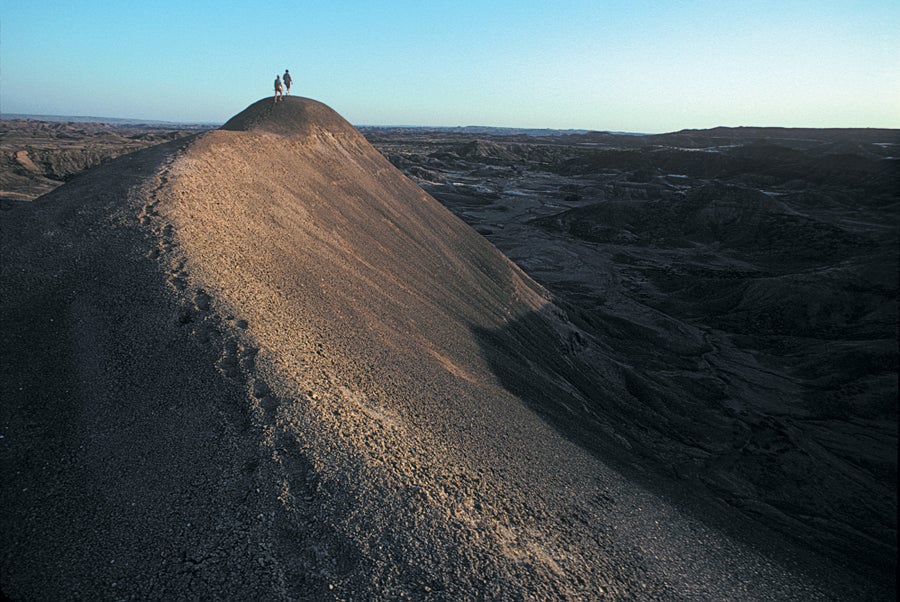
In 1972 researchers traveled to the Afar region of northeastern Ethiopia to look for hominin fossils dating to more than three million years ago. A site called Hadar looked especially promising, its rugged landscape chock-full of mammal fossils that erode out of the hillsides over time.
On supporting science journalism
If you’re enjoying this article, consider supporting our award-winning journalism by subscribing. By purchasing a subscription you are helping to ensure the future of impactful stories about the discoveries and ideas shaping our world today.
We have also learned a lot about Lucy’s own predecessors—and her contemporaries. One of the most exciting developments in the field of human origins research since the discovery of Lucy has been the revelation that for most of our prehistory multiple human species, or hominins, roamed the planet. One of us (Haile-Selassie) has found hominins that overlapped in time and space with Lucy’s kind. These members of the human family are fascinating in their own right. They also provide vital context for understanding the evolution of the species that may very well have given rise to us all.
To understand why Lucy had such a massive impact on paleoanthropology, we have to look at the state of the science at the time of her discovery. Back in the early 1970s, the oldest hominin fossils on record were thought to be around 2.5 million years old and belonged to a species called Australopithecus africanus from South Africa. Younger fossils fell into one of two groups: the so-called robust australopiths, with their giant molars and powerful jaws, and the more delicately built, or “gracile,” forms, which included Homo. Although Au. africanus was classified as gracile, it didn’t particularly resemble either of these later groups. Yet it was the only sufficiently well-documented hominin we had that was old enough to be ancestral to them. There were a few scraps of fossil material from eastern Africa that were older, but there wasn’t enough material preserved to get a good sense of the kinds of creatures they came from. And so scientists drew their evolutionary trees with Au. africanus as the all-important ancestor of Homo and the robust forms. But what they really needed to test that hypothesis about Au. africanus were more complete fossils in excess of three million years old.
In the spring of 1972 Johanson journeyed to Ethiopia with French geologist Maurice Taieb in search of hominin fossils from beyond the three-million-year mark. Taieb was keen to take him to the Afar region of northeastern Ethiopia, where he had previously seen pig and elephant fossils that looked to be from the time period Johanson was targeting. Perhaps hominin fossils were there, too, waiting to be discovered. Surveying a bunch of fossil-bearing locations in the region, the team zeroed in on a site called Hadar. Brimming with fossils of rodents, elephants, rhinos, hippos, monkeys, horses, antelopes and carnivores, Hadar must have been a bountiful environment millions of years ago to support so many animals. It seemed like a promising area to search for ancient human ancestors. Johanson knew that if hominin fossils were found there, they could upend our understanding of how humans came to be.
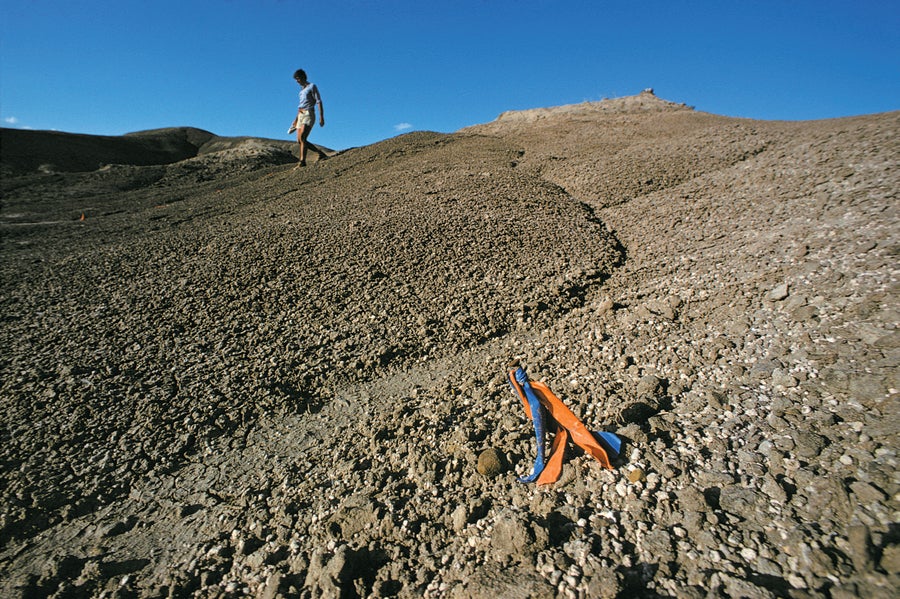
On November 24, 1974, Donald C. Johanson discovered the nearly 3.2-million-year-old Lucy skeleton on one of the hillsides. A stake marks the spot where the fossil was found.
When the expedition team returned to Hadar the following year, Johanson made a tantalizing discovery: a knee joint estimated to be 3.4 million years old. Anatomical details of the knee indicated that it had come from a hominin that walked upright, like us, confirming the fossil hunters’ hunch that Hadar had hominins. Johanson suspected the knee belonged to an Australopithecus individual, but without more anatomical information to go on, he could not determine whether it came from Au. africanus or a new species. What the team needed most was to find remains of skulls and teeth, the body parts that contain the most diagnostic features for distinguishing species in fossil mammals. The researchers could only hope that the next field season would turn up cranial and dental specimens.
Their dream came spectacularly true on that momentous day in 1974. The Lucy fossil preserved skull fragments and a lower jaw with teeth, as well as parts of the arm, leg, pelvis, spine and ribs—47 bones in all representing a whopping 40 percent of the skeleton of a single individual. Her remains promised untold insights into the human past.
Named after the Beatles song “Lucy in the Sky with Diamonds,” which played on the tape deck at camp as the team celebrated, Lucy became an instant sensation. Nothing like her had ever been found before. She was diminutive—her 12-inch-long thigh bone indicated that she stood only three and a half feet tall and weighed 60 to 65 pounds. Like many other animals, early hominins exhibit a condition called sexual dimorphism, wherein males are much larger than females, among other morphological differences. Lucy was too small to be a male. And her erupted wisdom teeth and lack of unfused growth plates in her limb bones confirmed she was an adult.
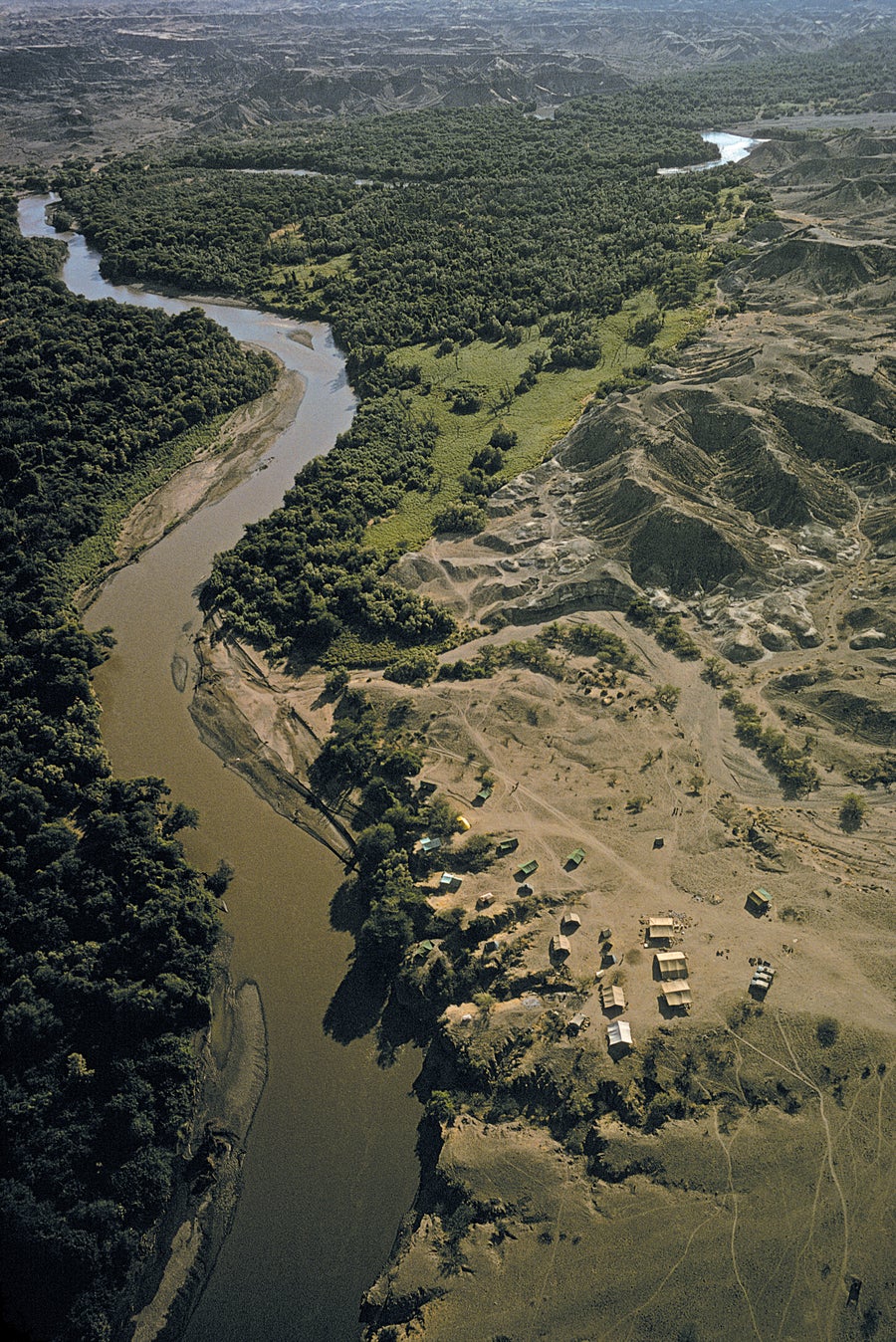
The expedition camped along the banks of the Awash River and began a targeted search of the area’s fossil-bearing sediments.
Other features attested to how she carried herself. After closely inspecting her knee, hip and ankle, as well as conducting extensive biomechanical studies, Johanson and his colleagues concluded that she walked upright—a trait that Charles Darwin argued was a hallmark of humans—with a gait very much like our own. Other scholars interpreted the bones differently, arguing that she walked with her knees and hips bent like chimpanzees do when they occasionally travel on two legs. Final resolution of this debate came in 1978, after researchers discovered a stunning trail of hominin footprints impressed in 3.7-million-year-old volcanic ash at the site of Laetoli in Tanzania. Some of the prints are so detailed that all the characteristics of a modern human footprint left on a beach are visible. They showed that the Laetoli track makers walked like us, not like chimpanzees. And because hominin teeth and jaws similar to those from Hadar had been found at Laetoli, it stood to reason that Lucy’s kind left the prints.
Traits such as a receding chin, strongly projecting snout, low and sloping forehead, and very small brain size placed Lucy in the genus Australopithecus. But certain aspects of her anatomy hinted that she might be more primitive than other known species in that group. Her first lower premolar was oval in shape and had a single cusp, like an ape’s. Likewise, her lower limbs were relatively short, possibly an evolutionary feature left over from her ancestors who lived a more arboreal life. Although only bits of her braincase were recovered, the fragments suggested a brain volume of 388 cubic centimeters. That’s very small compared with the modern human brain, which averages 1,400 cubic centimeters, and comparable to the average modern chimp brain. Lucy confirmed earlier suspicions that upright walking evolved before large brains.
With so many parts of her skeleton preserved, Lucy was a trove of information. But she was still just one individual. For a deeper understanding of her species, we needed more specimens. To that end, continued fieldwork at Hadar and other sites in the region has yielded a wealth of additional Au. afarensis fossils that together provide a detailed portrait of this ancestor.
In 1975, just one year after Lucy was found at Afar Locality 288, the Hadar team discovered more than 200 fossil hominin specimens eroding from a single layer of rock at nearby Afar Locality 333. Dated to a little more than 3.2 million years ago, the sample consisted of male and female adults as well as portions of infants and juveniles estimated to represent at least 17 individuals, all presumably related. The group became known as the “First Family.”
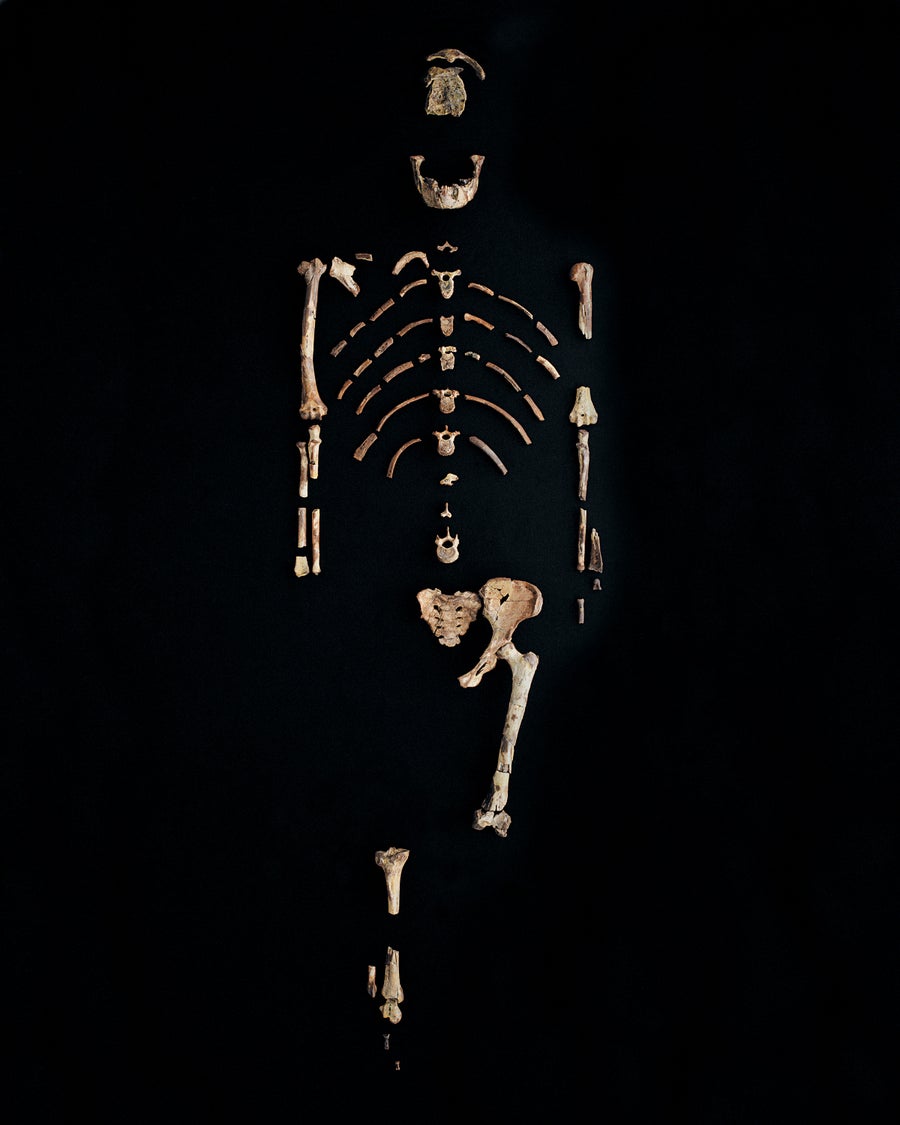
When Lucy was discovered 50 years ago, she was the oldest, most complete early member of the human family that had ever been found, with 47 bones representing 40 percent of the skeleton. Features of her hip, knee and ankle indicate that she walked upright on two legs like we do. Yet in other respects she was primitive, with a brain less than a third of the size of our own.
Combining the expanded Hadar collection with Lucy’s Tanzanian counterparts allowed the team to reconstruct the skull of the hominin species found at Hadar and to evaluate the fossils’ taxonomic status and position on the human family tree. In 1978, following a thorough comparative study of all the australopith species then known, Johanson and his colleagues concluded that although some of the dental and cranial features evident in these remains are found in other members of Australopithecus, the total morphological package seen in the Hadar and Laetoli fossils was unique and constituted a species new to science: Australopithecus afarensis. Furthermore, they proposed, Au. afarensis occupied a prominent position on the family tree, replacing Au. africanus as the last common ancestor of later hominins, including Homo and the robust australopiths.
Not everyone in the paleoanthropological community embraced the naming of this new species. Detractors argued that the hominin record between two million and three million years ago was too sparse to support the claim that Au. afarensis was the ancestor of later hominins. The discovery of more fossils from this time period would be crucial for testing this hypothesis.
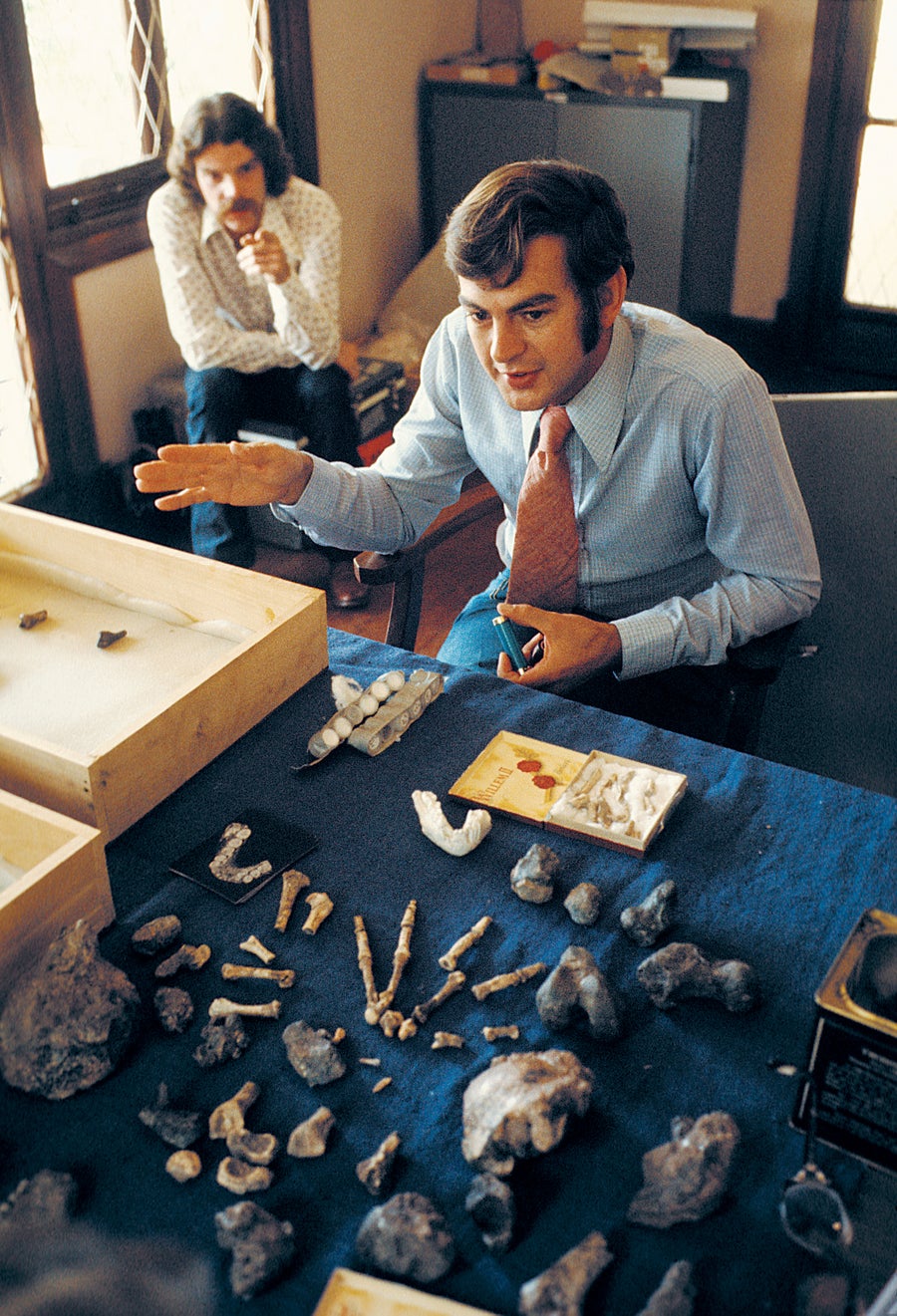
In 1975 Johanson, shown here with graduate student Tom Gray, discovered fossils from a group of hominins—dubbed the First Family—who had died together at another locality in Hadar and belonged to the same species as Lucy.
That additional evidence has since come in. In 1985 researchers working in northern Kenya discovered a 2.5-million-year-old cranium of the robust australopith Paranthropus aethiopicus. Dubbed the “Black Skull” for its manganese-tinged color, it possessed a powerful masticatory system, including large crushing and grinding teeth, similar to those of a robust australopith individual sometimes referred to as “Nutcracker Man,” who lived 1.8 million years ago and belonged to the species Paranthropus boisei. The Black Skull also shared several traits with Au. afarensis, including an extremely projecting lower face. When the three species are considered together, Au. afarensis is a compelling ancestor for P. aethiopicus, which in turn appears ancestral to P. boisei.
Further support for the hypothesis that Au. afarensis gave rise to later australopiths in eastern Africa came in 1990, when a cranium the same age as the Black Skull surfaced in Ethiopia’s Middle Awash Valley. The discovery team deemed it a new species, Australopithecus garhi, and claimed that it occurred at the right time and place to be ancestral to Homo. Like the robust australopiths, this specimen had an impressive masticatory system, with big jaws and a crest atop its head that would have anchored strong chewing muscles. It also had a facial structure similar to that of Au. afarensis. Other scientists have surmised that Au. garhi descended from Au. afarensis and evolved its formidable chewing anatomy in parallel with the robust australopiths but did not itself give rise to later hominin species.
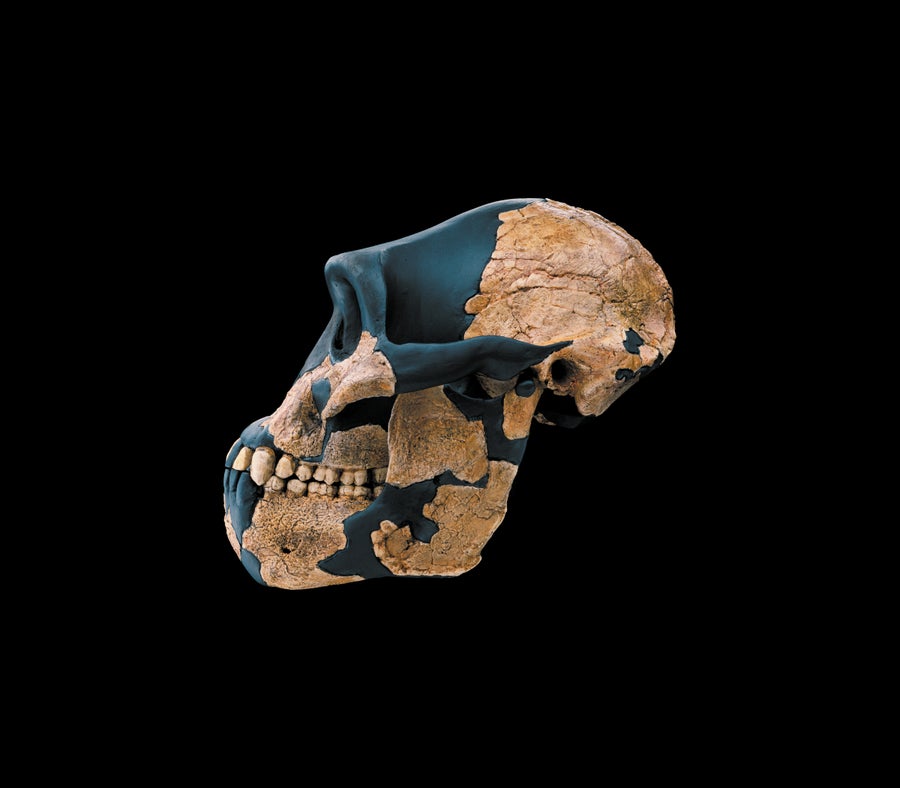
Cranial and dental remains from this find allowed researchers to reconstruct the skull of that species, Australopithecus afarensis.
Other fossil finds bolstered the proposed link between Au. afarensis and Homo. For a long time the oldest known fossils in the genus Homo dated only as far back as around two million years ago, leaving a worrying gap of more than a million years between the youngest Au. afarensis and the oldest Homo. In 1994 researchers at Hadar found a 2.33-million-year-old palate—the bone that makes up the roof of the mouth—that shared morphological traits with Homo habilis, “Handy Man,” the earliest known member of our genus, narrowing that temporal gap by a few hundred thousand years. And in 2013 a team working at a site northeast of Hadar called Ledi-Geraru recovered the left half of a 2.8-million-year-old mandible bearing a combination of primitive Au. afarensis features and characteristics of early Homo. The Ledi-Geraru jaw provided another stepping stone between Au. afarensis and Homo and strengthened the morphological connection between them as well, helping to validate the hypothesis that Au. afarensis is the best candidate we have for the ancestor of our own genus.
Human fossils are generally rare, which means that our understanding of the past can change dramatically when new specimens surface. When Au. afarensis was named as a new species in 1978, it was the earliest human ancestor ever documented, with an age range of 3.8 million to 3.0 million years ago. Fossils recovered in the mid-1990s extended the early hominin record back even farther. In 1994 researchers working in the Middle Awash region of Ethiopia’s Afar Rift found hominin fossils dated to 4.4 million years ago. They assigned the remains to a new species, Ardipithecus ramidus. The following year another new species was named based on fossil discoveries from Kanapoi and Allia Bay in Kenya’s Turkana Basin: Australopithecus anamensis, which lived from 4.3 million to 3.8 million years ago. With the naming of these two species, Au. afarensis lost the distinction of being the oldest hominin, but it gained an origin story of its own: Au. anamensis is believed to be the direct ancestor of Au. afarensis. More recently, discoveries in Chad, Kenya and Ethiopia have pushed the origin of humankind back as far as seven million years.
Other fossil finds have shown that Au. afarensis was not the only hominin species around during its long reign, raising the question of whether Au. afarensis or one of these other hominins is the ancestor of Homo and Paranthropus. Far from diminishing the significance of Lucy’s species, these findings enrich its story: we now have many more puzzle pieces from which to reconstruct the evolution of the line that led to us and the factors that shaped it along the way. The picture that is emerging from this work is far more complex—and fascinating—than the one paleoanthropologists traditionally envisioned.

Prior to 1960, human origins researchers thought that only a single hominin species lived at any given time in the past. This notion stemmed from the idea that competition prohibits the coexistence of related species with similar adaptations, a principle known as competitive exclusion. The fossil record of hominins seemed to support this concept until fossils of two different hominin species were recovered from the same geological layer at sites in Kenya and Tanzania. Still, there was no evidence that another species lived alongside Au. afarensis, and because of that, it was considered to be the ancestor of all later hominins.
Eventually, however, challengers turned up from various sites in eastern and central Africa. In 1995 a team lead by paleontologist Michel Brunet discovered a 3.5-million-year-old partial hominin jaw from a site in northern Chad known as Koro-Toro and assigned it to a new species, Australopithecus bahrelghazali. This fossil was significant not only because it was found outside the East African Rift System, where almost all early hominins have been recovered, but also because it overlapped in time with Au. afarensis. Not everyone agreed that the jaw was distinctive enough to represent a new species. Nevertheless, it was the first hint that Au. afarensis may not have been the only hominin species around 3.5 million years ago.
A second hint came in 2001, when paleontologist Meave Leakey and her team announced their discovery of a 3.5-million-year-old cranium from Lomekwi, a site in northwest Kenya, and assigned it to a new genus and species called Kenyanthropus platyops, partly on the basis of what they saw as a distinctive flatness of its face. Critics also challenged the validity of this species, arguing that the badly crushed skull was too distorted for its true shape to be discernible. Regardless, it was another indication that Au. afarensis might not have been alone—even in eastern Africa.
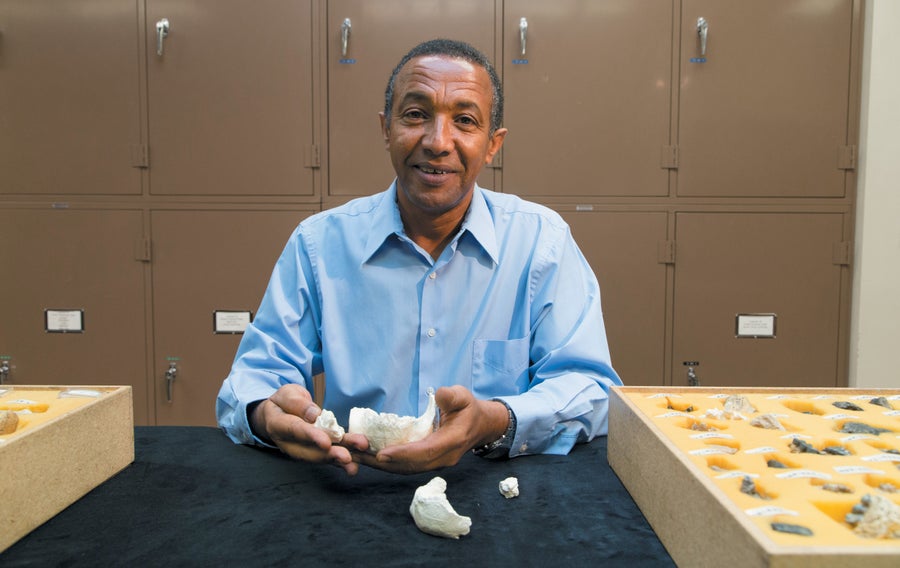
For the past two decades Yohannes Haile-Selassie has been working at a fossil site some 40 kilometers north of Hadar called Woranso-Mille. There he has recovered fossils belonging to contemporaries of Au. afarensis, including jawbones belonging to a species called Australopithecus deyiremeda and afoot belonging to a yet unidentified species that had a diver gent big toe like an ape’s.
Cleveland Museum of Natural History
More recently, Haile-Selassie has found the strongest evidence yet that Au. afarensis had company. Two decades ago he set out to look for new paleontological sites in the Afar Rift containing hominin fossils between three million and four million years old. His efforts resulted in the discovery of a spectacular new site called Woranso-Mille just 40 kilometers north of Hadar. With fossils spanning the time from 3.8 million to 3.0 million years ago, it has become one of the most important sites in all of Africa for hominins from the Pliocene epoch.
Perhaps the most remarkable aspect of Woranso-Mille is the diversity of hominins found there. The site has yielded remains of both Au. anamensis (including a nearly complete skull that has given us our first look at the face of this ancestor) and its descendant, Au. afarensis. It has also produced other hominins. In 2012 Haile-Selassie and his colleagues announced their discovery of an enigmatic hominin foot with a divergent big toe more like an ape’s. At 3.4 million years old, it was contemporaneous with Au. afarensis. Yet it clearly did not come from that species, whose big toe lined up with the other digits, like ours does. Without any associated skull or tooth remains to guide them, the researchers did not want to assign the foot to a species. But it showed beyond any doubt that Lucy’s species shared the landscape with a fundamentally different kind of hominin.
Further evidence that Au. afarensis overlapped with other hominins came in 2015, when Haile-Selassie and his colleagues announced their discovery of fossilized upper and lower jaws from a species new to science, Australopithecus deyiremeda. Dated to 3.3 million to 3.5 million years ago, this species was contemporaneous with both Au. afarensis and the owner of the mysterious foot that was recovered from the same site. Whether the foot belongs to Au. deyiremeda, given the proximity of the finds, remains to be seen.
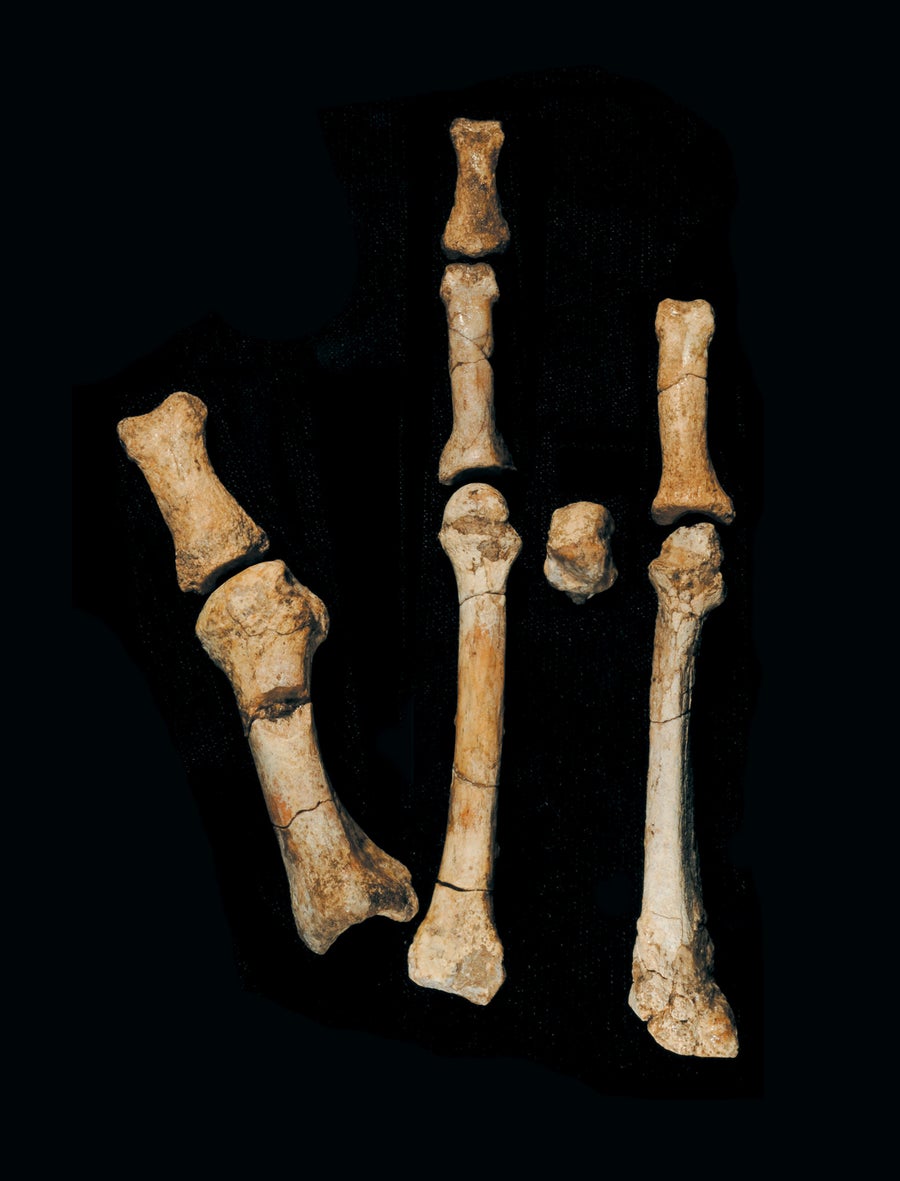
A foot belonging to a yet unidentified species that had a divergent big toe like an ape’s.
Cleveland Museum of Natural History
The discoveries at Woranso-Mille show that Au. afarensis didn’t just share the same continent or even the same side of the continent with other hominin species but lived virtually side by side with them. They may have been able to do this by exploiting different ecological niches within the same area. The species with the divergent big toe probably could have climbed trees more efficiently than Au. afarensis, for example, and so might have focused on arboreal resources while Au. afarensis favored terrestrial ones.
Comparison of the paleoenvironments at the sites where these fossils are found may provide further clues. Hadar and Woranso-Mille are similar in having hosted both Au. afarensis and other nonhominin mammals simultaneously. But only Woranso-Mille had more than one hominin species. Why were there multiple contemporaneous hominin species at Woranso-Mille and not at nearby Hadar? One hypothesis we are testing is that Woranso-Mille encompassed a greater diversity of habitats, which could have supported multiple hominins without substantial direct competition.

Jawbones belonging to a species called Australopithecus deyiremeda.
Cleveland Museum of Natural History
The realization that Au. afarensis might have had as many as three other hominin contemporaries has raised questions about the claim that it was the ancestor of all later hominins, including members of Homo. We have to consider whether any of these other species may be a better candidate ancestor than Au. afarensis. In practice, it’s hard to connect the dots with certainty. One big problem is that the sample sizes of these other species are too small to allow for meaningful comparisons. For example, researchers have argued that K. platyops had a flat face like early Homo and could thus be considered the ancestor of that genus. But we have only one skull of K. platyops to go on, and it’s badly crushed. Did this creature actually have a flat face, or did its poor preservation distort its true features? We would need well-preserved skulls of this species to know. What is more, K. platyops is separated from its proposed descendant, Homo rudolfensis, by about a million years, making it difficult to link the two. If we had more fossils of K. platyops from different time periods to establish how long this species persisted, we might be able to bridge that gap, but we don’t.
We simply don’t have enough information about K. platyops or the other Au. afarensis contemporaries to know what kinds of creatures they were and how they are related to the rest of the human family. That leaves Au. afarensis—represented by hundreds of fossils from numerous individuals, juvenile and adult, spanning some 800,000 years—as the best candidate ancestor of Homo and Paranthropus. As additional fossils of these more recently identified hominins come to light, perhaps one of them might emerge as the front-runner. Until then, Au. afarensis remains the most likely ancestor and one of the most important species in human evolutionary history.
